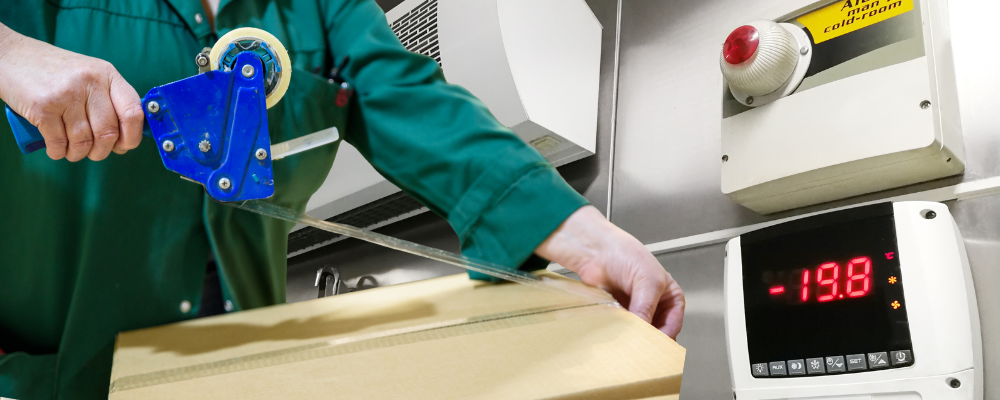By Josh Ubel | December 28, 2023 | Carton Sealing Tape, Cold Temp Tape | 0 Comments

Tape for Cold Temperatures
Updated: 6-17-2025
If you’re working in a cold storage facility, packing frozen foods, or shipping boxes through winter weather, you’ve probably run into this problem: tape that just won’t stick. It peels, pops, or gives up entirely once the temperature drops. That’s not just annoying but it can lead to damaged products, safety issues, and extra costs.
That’s where cold temperature tape comes in. It’s built to hold strong in freezing environments, whether you're sealing boxes in a refrigerated warehouse or prepping shipments for sub-zero delivery. This guide breaks down what makes cold temp tape different, how to choose the right kind, and how to get the best results.
What Makes Cold Temperature Tape Different?
Cold temperature tape, also known as freezer tape or cold weather tape, is designed with special adhesives that stay sticky even when it’s freezing. Standard tape tends to harden and lose grip in the cold, but cold temp tape stays flexible and holds tight.
It’s commonly used in:
- Refrigerated and frozen food packaging
- Cold chain logistics
- Outdoor shipping and storage during winter
If you’re curious how tape interacts with different box materials, check out this quick guide.
Why Regular Tape Doesn’t Cut It
Most standard tapes are made for room temperature environments. Once the temperature drops, the adhesive stiffens up and stops bonding properly. That’s when you start seeing:
- Tape lifting at the edges
- Boxes popping open in transit
- Products getting damaged or exposed
If you’ve ever had to re-tape a pallet in a freezer, you know how frustrating that can be. For a deeper dive into tape performance, take a look at The Ultimate Guide to Carton Sealing Tape.
Two Main Types of Cold Temp Tape
Acrylic Adhesive Tape
Acrylic tape is a solid choice for long-term storage and outdoor shipping. It holds up well in cold and fluctuating temperatures, and it resists UV and chemicals too.
- Apply as low as 32°F
- Performs down to -20°F
- Best for: Long hauls, outdoor storage, or anything that needs to last
Natural Rubber Adhesive Tape
Natural rubber tape sticks fast and works well on rough or recycled surfaces. It’s great for quick jobs, but it doesn’t handle extreme cold quite as well as acrylic.
- Apply around 32°F
- Best for: Fast application, short-term use, or tricky surfaces
If you're interested in these types of tapes and looking to purchase, be sure to check out the Tape Catalog .
What to Think About Before You Choose
Here are a few things to keep in mind when picking cold temp tape:
What to Consider Why It Matters Application Temperature Tape needs to bond properly when it's applied. Service Temperature It also needs to hold up during storage or shipping Surface Type Rough or recycled boxes may need stronger adhesives. Storage Conditions Tape should be stored at room temp before use.
Tips for Using Cold Temperatures effectively
Getting the most out of your tape isn’t just about picking the right roll-it’s also about how you use it:
- Keep tape warm before using it. Store it at room temperature.
- Apply in a warmer area, if possible, then move to cold storage.
- Use a tape dispenser to apply even pressure and get a clean seal.
- Test it first on your actual packaging before rolling it out across the floor.
Who Uses Cold Temp Tape?
Cold temp tape is a go-to for a lot of industries:
- Food and beverage: Frozen meals, dairy, meat, and produce
- Pharma and healthcare: Cold chain compliance and safety
- E-commerce and retail: Winter shipping and seasonal fulfillment
- Manufacturing and distribution: Outdoor storage and cold-weather operations
Final Thoughts
If your packaging process involves cold temperatures, using the right tape for cold temperatures, whether it’s cold weather tape for outdoor shipping or low temperature adhesive tape for refrigerated storage, makes a big difference. It keeps boxes sealed, products protected, and operations running smoothly.
Not Sure Which Type of Tape Is Right for Your Facility?
Click here to chat now to get help with exploring your options and finding the perfect tape for your needs.
About the Author: Josh Ubel
Josh Ubel is an experienced industrial packaging and automation specialist with over 18 years of experience in the manufacturing industry. He focuses on providing practical solutions that help customers solve problems, optimize operations, cut costs, and achieve their goals.
Josh is committed to helping businesses adopt automation and technology to address labor challenges.
Outside of work, Josh enjoys spending time with his wife and two daughters, enjoying outdoor activities in Minnesota and Wisconsin, such as fishing, swimming, boating, golfing, and ATVing. He also enjoys barbecuing and cooking for family and friends.
Need Help?
Increase your productivity with entry-level of full-line packaging automation, reduce packaging costs, and increase product protection with a full catalog of packaging supplies.